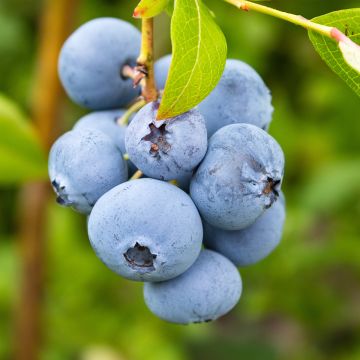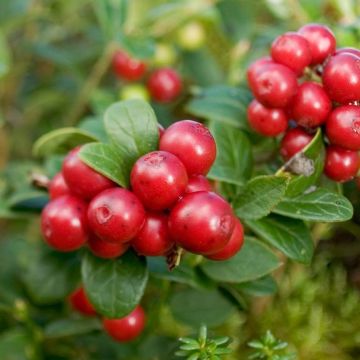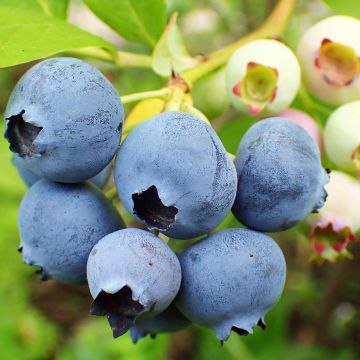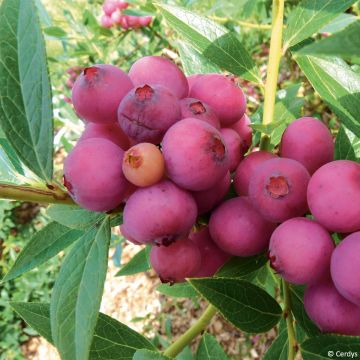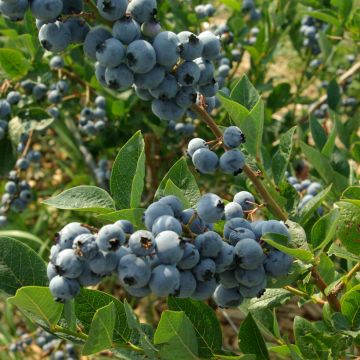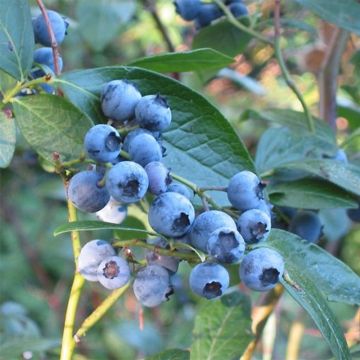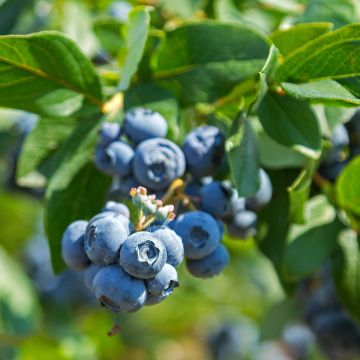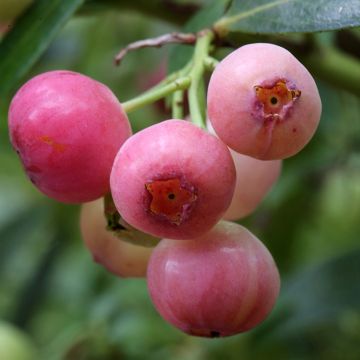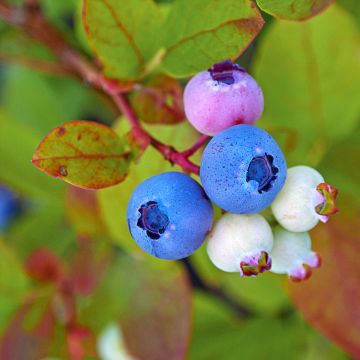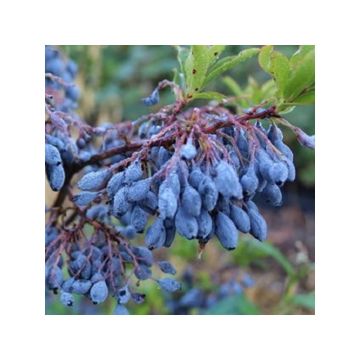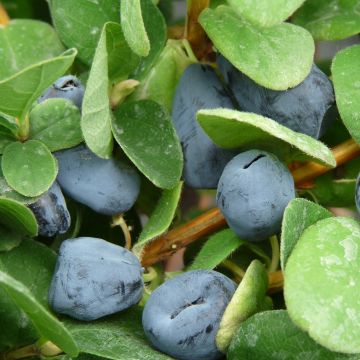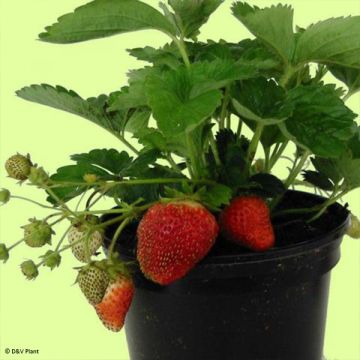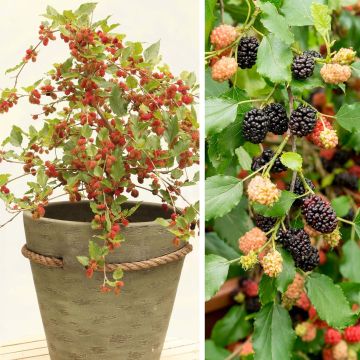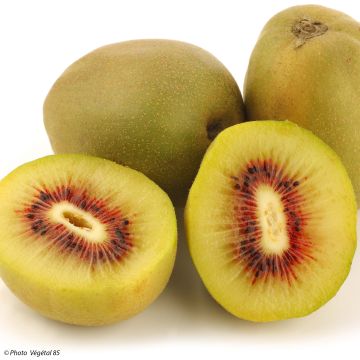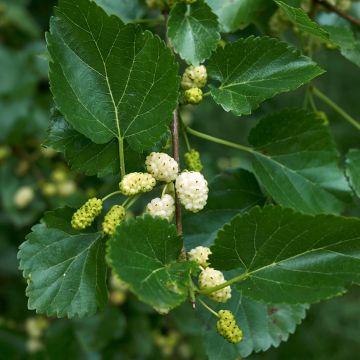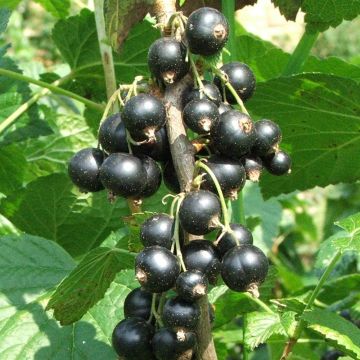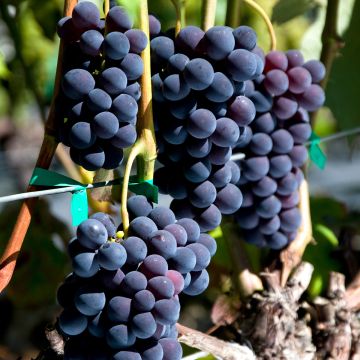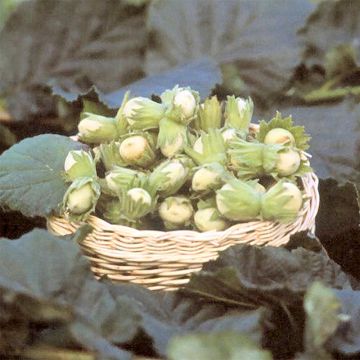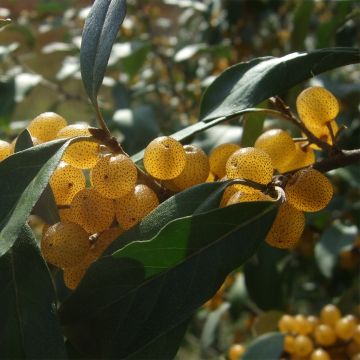

Vaccinium corymbosum Hardyblue - blueberry
Vaccinium corymbosum Hardyblue - blueberry
Vaccinium corymbosum Hardyblue
Highbush blueberry, Tall huckleberry, Swamp huckleberry, High blueberry, Swamp blueberry
This item cannot be shipped to the selected country
Delivery charge from €5.90
More information
Schedule delivery date,
and select date in basket
This plant carries a 6 months recovery warranty
More information
We guarantee the quality of our plants for a full growing cycle, and will replace at our expense any plant that fails to recover under normal climatic and planting conditions.
From €5.90 for pickup delivery and €6.90 for home delivery
Express home delivery from €8.90.
Description
Vaccinium corymbosum 'Hardyblue' is highly prized for its sweet and juicy, low-acid fruits and high yield. This vigorous, dense and upright North American, shrub has abundant and branching vegetation. In May, it produces attractive white bell-shaped flowers that are loved by bees, followed by round berries, bluish when ripe in August. In autumn, its leaves take on magnificent fiery hues before falling. This variety is self-fertile and a single plant will produce a satisfactory harvest, but for increased yield, plant other varieties of blueberries nearby. It is easy to grow, and resistant to diseases and cold temperatures. Plant it in autumn in moist, fertile, and slightly acidic soil, preferably in a shaded location.
The Blueberry bush, in Latin Vaccinium corymbosum, belongs to the Ericaceae family, just like Red Cranberries, heathers, and rhododendrons. The blueberry bush, also known as American Blueberry, Corymb Blueberry, Giant Blueberry, or Blueberry, is native to North America, where it grows naturally in acidic, moist, sandy, or peaty soils, along lakes and rivers, in heathlands, woodlands, and alpine meadows up to 1600 m altitude. It is this species that is cultivated in Europe, available in a large number of cultivars selected for the quality and quantity of their fruits. This shrub is extremely cold-hardy (up to -30°C) with deciduous foliage, which falls in autumn, cannot tolerate limestone at all and requires a very acidic soil (pH 4 to 5.5).
Vaccinium corymbosum 'Hardyblue' forms a bushy, dense shrub reaching 1.50 to 1.80 m high with a spread of 1 to 1.20 m. Like most blueberries, its growth is relatively slow. The foliage consists of medium green elliptical and pointed leaves, measuring 6 to 7 cm long and about 3 cm wide. In autumn, they take on beautiful shades ranging from scarlet red to yellow, before falling. As an additional attraction, the branches take on lovely winter colours in shades of red. In May, the flowers appear as white bell-shaped, 0.5 to 1 cm long blossoms in 2 to 5 cm long, pendulous clusters at the ends of the stems. They are attractive to bees and pollinating insects in the garden. This is followed by the formation of numerous clusters of round, medium to large, 10 to 15 mm diameter, bluish-purple fruits covered with a light whitish bloom. The berries contain firm and juicy translucent yellowish pulp, containing the seeds. The 'Hardyblue' variety is self-fertile, it does not need a companion to bear fruit, but another variety of blueberry nearby, such as 'Blue Crop', 'Ivanohe', 'Legacy', 'Spartan', will increase production.
The harvest of Hardyblue blueberries begins in late July and continues until early September, giving the advantage of staggered harvesting. Blueberries should be picked when fully ripe, when they are dark blue, they are then sweet and tangy, juicy and flavourful. They are delicate fruits that must be carefully picked, and washed. They keep better in the refrigerator. Harvesting is easy, and it is very enjoyable to eat the fruits on the spot or to keep them for various culinary uses: jellies, jams, sorbets, coulis, syrups, juices, liqueurs, crumbles, muffins... not to mention the famous blueberry pies... Blueberries are low in calories, but rich in minerals (manganese, potassium, magnesium, iron), vitamin C and K, fibre, and antioxidants to contribute to a balanced diet.
American Hardyblue Blueberry is hardy to -30°C and thrives in a slightly acidic to acidic soil, with a preference for fertile, well-drained, moist soils, without limestone. Once established, it quickly becomes a magnificent ornamentalal plant for your garden. Avoiding overly sunny exposures, it can be grown with other fruit trees to create a gourmet hedge, such as May Berry (Lonicera kamchatka), raspberries, blueberries, garden blackberries, red currants, or blackcurrants. These plants are vigorous and undemanding, making them perfectly suited for a natural garden. In ornamental gardens, Hardyblue blueberry will blend beautifully with ericaceous shrubs, adding colour to the foliage as well as intensity and duration to flowering and fruiting.
Report an error about the product description
Plant habit
Fruit
Flowering
Foliage
Botanical data
Vaccinium
corymbosum
Hardyblue
Ericaceae
Highbush blueberry, Tall huckleberry, Swamp huckleberry, High blueberry, Swamp blueberry
Cultivar or hybrid
Other Blueberry bush
Planting and care
Plant the Blueberry Bush in autumn or any time of the year outside of the freezing and scorching periods. Plant in partial shade, at the edge of the undergrowth, in clear undergrowth or in an east-facing position, without direct sunlight. It is very hardy (-30°C for the plant but -5°C for the flowers) and will be easy to grow if the soil and exposure are suitable. If you plant multiple plants, space them 1.20 to 1.50 metres apart in all directions.
Plant it in a very acidic to acidic soil (pH between 4 and 5.5), incorporating ericaceous soil or a mixture of ordinary soil and well-decomposed bark compost. The collar should be level with the ground. Firm down and water generously with non-chalky water. In slightly chalky to neutral soil, dig a hole 50 to 60 cm deep, line the edges with garden felt and then fill with a mixture of potting compost and ericaceous soil, enriched with compost.
The soil should remain moist to wet. If watering is necessary, use non-limestone and non-chlorinated water (e.g. rainwater). Mulch the base with shredded bark, straw, or fern leaves. It can be a good idea to place a protective net if birds become too greedy during harvest time. Apply a little well-rotted compost on the surface annually, in spring. The blueberry bush is not very susceptible to diseases and pests.
Planting period
Intended location
Care
This item has not been reviewed yet - be the first to leave a review about it.
Berries
Haven't found what you were looking for?
Hardiness is the lowest winter temperature a plant can endure without suffering serious damage or even dying. However, hardiness is affected by location (a sheltered area, such as a patio), protection (winter cover) and soil type (hardiness is improved by well-drained soil).

Photo Sharing Terms & Conditions
In order to encourage gardeners to interact and share their experiences, Promesse de fleurs offers various media enabling content to be uploaded onto its Site - in particular via the ‘Photo sharing’ module.
The User agrees to refrain from:
- Posting any content that is illegal, prejudicial, insulting, racist, inciteful to hatred, revisionist, contrary to public decency, that infringes on privacy or on the privacy rights of third parties, in particular the publicity rights of persons and goods, intellectual property rights, or the right to privacy.
- Submitting content on behalf of a third party;
- Impersonate the identity of a third party and/or publish any personal information about a third party;
In general, the User undertakes to refrain from any unethical behaviour.
All Content (in particular text, comments, files, images, photos, videos, creative works, etc.), which may be subject to property or intellectual property rights, image or other private rights, shall remain the property of the User, subject to the limited rights granted by the terms of the licence granted by Promesse de fleurs as stated below. Users are at liberty to publish or not to publish such Content on the Site, notably via the ‘Photo Sharing’ facility, and accept that this Content shall be made public and freely accessible, notably on the Internet.
Users further acknowledge, undertake to have ,and guarantee that they hold all necessary rights and permissions to publish such material on the Site, in particular with regard to the legislation in force pertaining to any privacy, property, intellectual property, image, or contractual rights, or rights of any other nature. By publishing such Content on the Site, Users acknowledge accepting full liability as publishers of the Content within the meaning of the law, and grant Promesse de fleurs, free of charge, an inclusive, worldwide licence for the said Content for the entire duration of its publication, including all reproduction, representation, up/downloading, displaying, performing, transmission, and storage rights.
Users also grant permission for their name to be linked to the Content and accept that this link may not always be made available.
By engaging in posting material, Users consent to their Content becoming automatically accessible on the Internet, in particular on other sites and/or blogs and/or web pages of the Promesse de fleurs site, including in particular social pages and the Promesse de fleurs catalogue.
Users may secure the removal of entrusted content free of charge by issuing a simple request via our contact form.
The flowering period indicated on our website applies to countries and regions located in USDA zone 8 (France, the United Kingdom, Ireland, the Netherlands, etc.)
It will vary according to where you live:
- In zones 9 to 10 (Italy, Spain, Greece, etc.), flowering will occur about 2 to 4 weeks earlier.
- In zones 6 to 7 (Germany, Poland, Slovenia, and lower mountainous regions), flowering will be delayed by 2 to 3 weeks.
- In zone 5 (Central Europe, Scandinavia), blooming will be delayed by 3 to 5 weeks.
In temperate climates, pruning of spring-flowering shrubs (forsythia, spireas, etc.) should be done just after flowering.
Pruning of summer-flowering shrubs (Indian Lilac, Perovskia, etc.) can be done in winter or spring.
In cold regions as well as with frost-sensitive plants, avoid pruning too early when severe frosts may still occur.
The planting period indicated on our website applies to countries and regions located in USDA zone 8 (France, United Kingdom, Ireland, Netherlands).
It will vary according to where you live:
- In Mediterranean zones (Marseille, Madrid, Milan, etc.), autumn and winter are the best planting periods.
- In continental zones (Strasbourg, Munich, Vienna, etc.), delay planting by 2 to 3 weeks in spring and bring it forward by 2 to 4 weeks in autumn.
- In mountainous regions (the Alps, Pyrenees, Carpathians, etc.), it is best to plant in late spring (May-June) or late summer (August-September).
The harvesting period indicated on our website applies to countries and regions in USDA zone 8 (France, England, Ireland, the Netherlands).
In colder areas (Scandinavia, Poland, Austria...) fruit and vegetable harvests are likely to be delayed by 3-4 weeks.
In warmer areas (Italy, Spain, Greece, etc.), harvesting will probably take place earlier, depending on weather conditions.
The sowing periods indicated on our website apply to countries and regions within USDA Zone 8 (France, UK, Ireland, Netherlands).
In colder areas (Scandinavia, Poland, Austria...), delay any outdoor sowing by 3-4 weeks, or sow under glass.
In warmer climes (Italy, Spain, Greece, etc.), bring outdoor sowing forward by a few weeks.

































